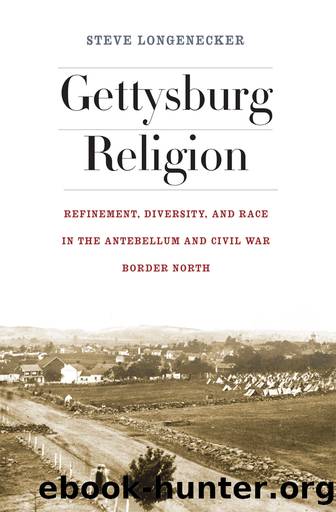Gettysburg Religion by Longenecker Steve;

Author:Longenecker, Steve; [Longenecker, Steve]
Language: eng
Format: epub
Publisher: Fordham University Press
Published: 2013-08-15T00:00:00+00:00
Gettysburg Day 1. Confederate forces drive back Union defenders, swarm around the seminary, and occupy the Schmucker home.
As the battle began, lingering African Americans escaped. Somehow they had survived Earlyâs brief occupation, but the unmistakable signs of a large engagement provided new impetus to leave. Basil Biggs, an influential member of the AME Zion fellowship, had sent his family away earlier, and as Confederates entered Gettysburg from the north and west, Biggs rode out of town, heading east, on a borrowed horse. He spent the battle in York. On July 1 Elizabeth and Abraham Brien left town with their children as the battle began. Perhaps their status as property owners caused them to linger longer than most.29
Sallie Myers heard a cannon shot at approximately 9 A.M. as she was ironing. The first evidence of fighting she glimpsed was a bloodstained horse led along the street and then came a soldier with a bandaged head and supported by comrades on either side. She thought it âsickening.â Myers spent the afternoon standing in a driving rain giving water to troops as they marched past. Abraham Essick, pastor of St. James Lutheran, watched the developing battle from his churchâs steeple before retreating to the parsonage basement, where he saw nothing but heard much. Nicholas and Elizabeth Codori in the center of town also sought refuge in their cellar. Myers, too, eventually took to her basement with neighbors, forming âa huddle of women and children, some crying and some praying.â She remembered this as the âawfullest timeâ when she saw little but heard the shells, the retreat of Union troops, and the âunearthly yelling of the pursuing Rebels.â A few retreating soldiers ran through her houseâin the back door and out the frontâbut afterwards the only item missing was a linen apron she had been ironing. As Myers and the others peered out the basement windows, they saw Union soldiers now prisoners, and the new captives stood close enough to talk with the women. The men expected to be sent South and requested Myers and the others to contact their relatives. âOne after the other,â she recalled, âthey gave us their names and the addresses of the persons to whom we were to write.â When Myers emerged from her basement shelter, she observed many Confederates in the street and a decapitated Union soldier lying there, whom she surmised had been overtaken by cavalry.30
Other civilians had similar experiences on the first day of the battle. One family watched enemy soldiers loot the house across the street from top to bottom and carry off household goods in a large wagon. They expected a similar fate but were spared. Michael Jacobs, the math and science professor at Pennsylvania College, had Confederate troops spend the night on the sidewalks in front of his house. They demanded entrance to his home in search of Union soldiers and quickly found three Yankees in the cellar. Jacobs thought the rank-and-file Southerners were taunting, but he considered the officers as âintelligent and polite gentlemenâ who welcomed conversation with civilians.
Download
This site does not store any files on its server. We only index and link to content provided by other sites. Please contact the content providers to delete copyright contents if any and email us, we'll remove relevant links or contents immediately.
| United States | Abolition |
| Campaigns & Battlefields | Confederacy |
| Naval Operations | Regimental Histories |
| Women |
In Cold Blood by Truman Capote(3138)
Steve Jobs by Walter Isaacson(2765)
The Innovators: How a Group of Hackers, Geniuses, and Geeks Created the Digital Revolution by Walter Isaacson(2499)
All the President's Men by Carl Bernstein & Bob Woodward(2264)
Lonely Planet New York City by Lonely Planet(2102)
The Room Where It Happened by John Bolton;(2032)
And the Band Played On by Randy Shilts(2014)
The Murder of Marilyn Monroe by Jay Margolis(1981)
The Poisoner's Handbook by Deborah Blum(1977)
The Innovators by Walter Isaacson(1972)
Lincoln by David Herbert Donald(1869)
A Colony in a Nation by Chris Hayes(1796)
Under the Banner of Heaven: A Story of Violent Faith by Jon Krakauer(1684)
Amelia Earhart by Doris L. Rich(1585)
The Unsettlers by Mark Sundeen(1584)
Birdmen by Lawrence Goldstone(1533)
Dirt by Bill Buford(1520)
Zeitoun by Dave Eggers(1517)
Decision Points by George W. Bush(1464)
